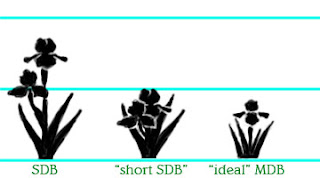by Tom Waters
Dwarf and Median Bearded Irises: Jewels of the Iris World
Kevin C. Vaughn
Schiffer Publishing, 2022
ISBN 978-0-7643-6389-4
144 pages
Books about bearded irises don’t come out nearly often enough, in my opinion. It’s been over a decade since Kelly Norris’s beautiful A Guide to Bearded Irises made its appearance, and it is especially exciting for some of us to see a book devoted to the dwarf and median classes. Whereas the heart of Norris’s book was profiles of favorite individual cultivars in all the different classes, Vaughn focuses on the classes themselves: why we grow them, where they come from, and where they are going.
The book has a simple and clear organization: a chapter for each dwarf and median class, a general chapter on culture, and a chapter on hybridizing. The last is quite innovative in books of this type. Most horticultural titles address readers solely as consumers—purchasers and growers of garden plants. But Vaughn is a lifelong hybridizer, and his enthusiasm for this hobby is infectious. It adds a whole other dimension to how we appreciate our irises, and Vaughn assumes that many of his readers will want to share this with him.
The chapters on each class set forth the distinctive qualities and uses of each, selling the reader on what each has to offer. But Vaughn goes further, giving us a historical overview of the development of each class. This dovetails nicely with the corresponding chapters in The World of Irises* (edited by Bee Warburton and Melba Hamblen, 1978), bringing each class up to present day. The work of important hybridizers who contributed to the development of each class is noted and summarized. This is an important contribution. Those who have been deep in the iris world for decades know this history, which is sort of a shared experience, transmitted by word of mouth and personal correspondence; but this book records that history and makes it accessible to newcomers.
The chapter on culture takes a very welcome, fresh approach to the subject. Instead of repeating the familiar instructions that seem to have originated a hundred years ago with gardeners in the UK and New England, Vaughn takes us on a tour of his own gardening experience in Massachusetts, Mississippi, and Oregon, and relates practices of other gardeners he has known. This opens up the subject, putting forth lots of good ideas without pretending there is a one-size-fits-all recipe.The hybridizing chapter was of special interest to me. It should be noted that an entire book could be devoted to this subject, so this presentation is necessarily condensed. Vaughn refers readers to the chapter by Kenneth Kidd in The World of Irises*, and indeed I think it is best to use these two resources in tandem. Total newcomers will need to work some to connect the dots as they read Vaughn’s chapter. The effort is one that pays off, though, as Vaughn has a lot to share with us about how a backyard gardener can approach a hybridizing program and what the special challenges are for working in each of the dwarf and median classes.
To sum up, this book makes a fine addition to the library of anyone interested in dwarf and median irises, particularly those of us sufficiently immersed in an iris obsession to appreciate this book’s attention to hybridizing and to history.


















